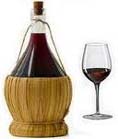How To Make Puff Pastry
from Italian Traditional Food
Advice on How To Make Puff
Pastry
Check out these great Italian ideas at Amazon for Italian food and kitchen ideas.
Learning how to make puff pastry
When learning how to make puff pastry there are three basic points to
remember.
First, the conditions in which you make puff
pastry: everything must be cool - ingredients, mixing bowl, pastry board, rolling pin, and, most important,
your hands.
Second, the first mixing of the dough is all-important. If the foundation dough is not right,
it's better to start again rather than waste your fat.
Finally, be absolutely sure of the way you roll out the pastry because this stage is vital.
The pressure on the rolling pin must always be firm and downwards, and roll one way only to make
sure pressure is even at all times. Puff pastry can be used for making bouchees, vol-au-vents and pastries.
Forming the dough
To have perfect results when making puff pastry, you must
use the right kind of flour and fat, and always use ice-cold water for mixing.
It is also important to work in a very cool atmosphere. Never attempt to make puff pastry in
very hot weather; it will become sticky and difficult to handle. Make it early in the morning (if possible before
you have done any cooking), as a kitchen soon becomes warm and steamy.
Fat should be cool and firm. The best puff pastry for flavour and
texture is made from butter; this should be of a firm consistency and slightly salted. If margarine has to be used,
again use a firm variety (one that does not spread easily). The cheapest varieties of butter and margarine are the
best for this purpose.
Flour should be "strong", ie. a bread flour which has a high glutten content. It should also be
well sifted and quite cool. The flour is made into a firm dough with a little butter and the water. This
preliminary mixing is most important as it is on this that the success of the pastry depends.
Add the lemon juice to approximately two-thirds of the given amount of water. Stir until a dough
begins to form, then add remaining water. If water is added a little at a time, it will dry in the flour and the
resulting dough will be tough. The finished dough should be firm yet pliable and have the consistency of butter,
taking into account the different textures.
Knead the dough firmly - this and the presence of the lemon juice develops the glutten in the
flour and means that the dough will stand the frequent rolling and folding necessary in the preparation of
puff pastry.
The butter should be cool and firm, but not used straight from the refrigerator. If it is
overhard (or not taken from the refrigerator early enough), put in between two pieces of damp greaseproof paper and
beat it 2-3 times with the rolling pin. It is then ready to be rolled into the dough.
Page 2 of this Italian Traditional Food article can be found on the next page.
Page 1 Next >>

Copyright © 2009 -
. All Rights Reserved Worldwide. Italian Traditional Food
You may not reprint articles from this website
without the written permission of the site owner.
Disclaimer: Articles on this
Website are provided for information purposes only. Italiantraditionalfood.com does not accept any responsibility
or liability for the use or misuse of the article content on this site or reliance by any person on the site's
contents.
| 


 Digg
Digg Stumbleupon
Stumbleupon Google Bookmarks
Google Bookmarks Delicious
Delicious Twitter
Twitter Facebook
Facebook Yahoo My Web
Yahoo My Web Reddit
Reddit